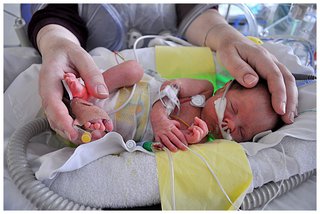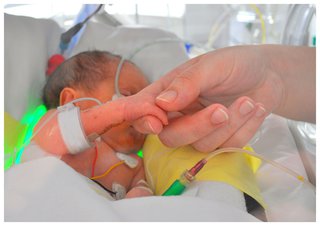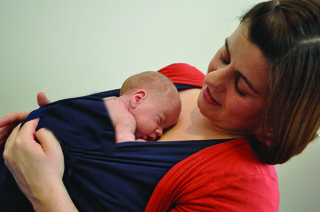Touching and holding your premature or ill baby helps you to connect with them. Your doctor, nurse or midwife will tell you when your baby is ready.
You may be able to try the comfort hold if your baby is in an incubator or on a breathing machine. There may be tubes and wires attached to your baby.
When they are stronger, you can do skin-to-skin contact using kangaroo care.
Read more about neonatal intensive care and special care baby units
Comfort hold for premature babies

At first, you might not be able to hold your premature or ill baby in your arms. But you can use the comfort hold to connect with them.
To do the comfort hold:
- Wash your hands.
- Place 1 hand on your baby’s head.
- Place the other hand on your baby’s feet.
You may also like to gently hold your baby’s hands and touch their feet.
If your baby is extremely premature, you should not stroke them. Ask your doctor, nurse or midwife for advice on the best way to touch your baby.


Kangaroo care for premature babies

When your baby is strong enough, you can try kangaroo care.
Kangaroo care is skin-to-skin contact holding your baby against your bare chest. Your baby wears just a nappy with your top and a blanket over their back. But they can wear clothes if they need to.
All babies benefit from the close contact, relaxation and warmth of kangaroo care.
Kangaroo care helps:
- increase your levels of oxytocin, the feel-good hormone
- stimulate your milk production
- develop your baby’s feeding and sucking instincts
Your baby will benefit from as much skin-to-skin contact as possible each day. You and your support person or partner can do kangaroo care.
Doing kangaroo care

Talk to your nurse or midwife to plan a time to do kangaroo care with your baby.
Before you do kangaroo care, have a shower and wear clean clothes. Wear a shirt that opens at the front or a loose t-shirt with no bra or vest. You can hold your baby under your shirt or top.
To do kangaroo care:
- Wash your hands.
- Greet and touch your baby to let them know you are there.
- Find a comfortable position.
- When you are ready, your nurse or midwife will gently put your baby on your chest under your top.
- With your baby’s head on your breastbone, support their back and bottom with your hands.
- Put a blanket over your baby’s back with the top of the blanket just under your baby’s ear.
Your nurse or midwife will check the position. You can use a mirror or camera phone to see your baby’s face.
For the most benefit, do kangaroo care for at least an hour so your baby goes through a full sleep cycle.
